#spring config server
Explore tagged Tumblr posts
Video
youtube
Create Spring Cloud Configuration Server for Microservices | Setup Eurek...
Full Video Link https://youtu.be/Exoy4ZNAO9Y
Hello friends, new #video on #springcloud #configserver #eureka #servicediscovery setup is published on #codeonedigest #youtube channel.
@java #java #aws #awscloud @awscloud @AWSCloudIndia #salesforce #Cloud #CloudComputing @YouTube #youtube #azure #msazure #configserver #configserverspringboot #configserverinmicroservices #configserverinspringbootmicroservices #configserverinspringbootexample #configserverspringbootgithub #configserverfirewall #configserverspringcloud #configserverspring #configurationserver #configurationserverspringboot #configurationserverdns #configurationserverinmicroservices #configurationserverstepbystep #eurekaservice #eurekaservicediscovery #eurekaserviceregistryspringboot #eurekaservicediscoveryexamplespringboot #eurekaserviceregistry #eurekaserviceinmicroservices #eurekaservicediscoveryexample #eurekaservicediscoveryspringboot #eurekaserviceregistryexample #eurekaservicespringboot
#youtube#spring cloud#spring cloud config#spring cloud config server#spring config server#configuration server#config service#config server#eureka service discovery#service discovery#service registry#netflix eureka#eureka service registry#service discovery pattern#microservices#microservice configuration server
1 note
·
View note
Text
Essential Components of a Production Microservice Application
DevOps Automation Tools and modern practices have revolutionized how applications are designed, developed, and deployed. Microservice architecture is a preferred approach for enterprises, IT sectors, and manufacturing industries aiming to create scalable, maintainable, and resilient applications. This blog will explore the essential components of a production microservice application, ensuring it meets enterprise-grade standards.
1. API Gateway
An API Gateway acts as a single entry point for client requests. It handles routing, composition, and protocol translation, ensuring seamless communication between clients and microservices. Key features include:
Authentication and Authorization: Protect sensitive data by implementing OAuth2, OpenID Connect, or other security protocols.
Rate Limiting: Prevent overloading by throttling excessive requests.
Caching: Reduce response time by storing frequently accessed data.
Monitoring: Provide insights into traffic patterns and potential issues.
API Gateways like Kong, AWS API Gateway, or NGINX are widely used.
Mobile App Development Agency professionals often integrate API Gateways when developing scalable mobile solutions.
2. Service Registry and Discovery
Microservices need to discover each other dynamically, as their instances may scale up or down or move across servers. A service registry, like Consul, Eureka, or etcd, maintains a directory of all services and their locations. Benefits include:
Dynamic Service Discovery: Automatically update the service location.
Load Balancing: Distribute requests efficiently.
Resilience: Ensure high availability by managing service health checks.
3. Configuration Management
Centralized configuration management is vital for managing environment-specific settings, such as database credentials or API keys. Tools like Spring Cloud Config, Consul, or AWS Systems Manager Parameter Store provide features like:
Version Control: Track configuration changes.
Secure Storage: Encrypt sensitive data.
Dynamic Refresh: Update configurations without redeploying services.
4. Service Mesh
A service mesh abstracts the complexity of inter-service communication, providing advanced traffic management and security features. Popular service mesh solutions like Istio, Linkerd, or Kuma offer:
Traffic Management: Control traffic flow with features like retries, timeouts, and load balancing.
Observability: Monitor microservice interactions using distributed tracing and metrics.
Security: Encrypt communication using mTLS (Mutual TLS).
5. Containerization and Orchestration
Microservices are typically deployed in containers, which provide consistency and portability across environments. Container orchestration platforms like Kubernetes or Docker Swarm are essential for managing containerized applications. Key benefits include:
Scalability: Automatically scale services based on demand.
Self-Healing: Restart failed containers to maintain availability.
Resource Optimization: Efficiently utilize computing resources.
6. Monitoring and Observability
Ensuring the health of a production microservice application requires robust monitoring and observability. Enterprises use tools like Prometheus, Grafana, or Datadog to:
Track Metrics: Monitor CPU, memory, and other performance metrics.
Set Alerts: Notify teams of anomalies or failures.
Analyze Logs: Centralize logs for troubleshooting using ELK Stack (Elasticsearch, Logstash, Kibana) or Fluentd.
Distributed Tracing: Trace request flows across services using Jaeger or Zipkin.
Hire Android App Developers to ensure seamless integration of monitoring tools for mobile-specific services.
7. Security and Compliance
Securing a production microservice application is paramount. Enterprises should implement a multi-layered security approach, including:
Authentication and Authorization: Use protocols like OAuth2 and JWT for secure access.
Data Encryption: Encrypt data in transit (using TLS) and at rest.
Compliance Standards: Adhere to industry standards such as GDPR, HIPAA, or PCI-DSS.
Runtime Security: Employ tools like Falco or Aqua Security to detect runtime threats.
8. Continuous Integration and Continuous Deployment (CI/CD)
A robust CI/CD pipeline ensures rapid and reliable deployment of microservices. Using tools like Jenkins, GitLab CI/CD, or CircleCI enables:
Automated Testing: Run unit, integration, and end-to-end tests to catch bugs early.
Blue-Green Deployments: Minimize downtime by deploying new versions alongside old ones.
Canary Releases: Test new features on a small subset of users before full rollout.
Rollback Mechanisms: Quickly revert to a previous version in case of issues.
9. Database Management
Microservices often follow a database-per-service model to ensure loose coupling. Choosing the right database solution is critical. Considerations include:
Relational Databases: Use PostgreSQL or MySQL for structured data.
NoSQL Databases: Opt for MongoDB or Cassandra for unstructured data.
Event Sourcing: Leverage Kafka or RabbitMQ for managing event-driven architectures.
10. Resilience and Fault Tolerance
A production microservice application must handle failures gracefully to ensure seamless user experiences. Techniques include:
Circuit Breakers: Prevent cascading failures using tools like Hystrix or Resilience4j.
Retries and Timeouts: Ensure graceful recovery from temporary issues.
Bulkheads: Isolate failures to prevent them from impacting the entire system.
11. Event-Driven Architecture
Event-driven architecture improves responsiveness and scalability. Key components include:
Message Brokers: Use RabbitMQ, Kafka, or AWS SQS for asynchronous communication.
Event Streaming: Employ tools like Kafka Streams for real-time data processing.
Event Sourcing: Maintain a complete record of changes for auditing and debugging.
12. Testing and Quality Assurance
Testing in microservices is complex due to the distributed nature of the architecture. A comprehensive testing strategy should include:
Unit Tests: Verify individual service functionality.
Integration Tests: Validate inter-service communication.
Contract Testing: Ensure compatibility between service APIs.
Chaos Engineering: Test system resilience by simulating failures using tools like Gremlin or Chaos Monkey.
13. Cost Management
Optimizing costs in a microservice environment is crucial for enterprises. Considerations include:
Autoscaling: Scale services based on demand to avoid overprovisioning.
Resource Monitoring: Use tools like AWS Cost Explorer or Kubernetes Cost Management.
Right-Sizing: Adjust resources to match service needs.
Conclusion
Building a production-ready microservice application involves integrating numerous components, each playing a critical role in ensuring scalability, reliability, and maintainability. By adopting best practices and leveraging the right tools, enterprises, IT sectors, and manufacturing industries can achieve operational excellence and deliver high-quality services to their customers.
Understanding and implementing these essential components, such as DevOps Automation Tools and robust testing practices, will enable organizations to fully harness the potential of microservice architecture. Whether you are part of a Mobile App Development Agency or looking to Hire Android App Developers, staying ahead in today’s competitive digital landscape is essential.
0 notes
Text
Why Java Spring Boot is Ideal for Building Microservices

In modern software development, microservices have become the go-to architecture for creating scalable, flexible, and maintainable applications. Java full-stack development is one of the most popular frameworks used for building microservices, thanks to its simplicity, powerful features, and seamless integration with other technologies. In this blog, we will explore why Java Spring Boot is an ideal choice for building microservices.
What are Microservices?
Microservices architecture is a design pattern where an application is broken down into smaller, independent services that can be developed, deployed, and scaled individually. Each microservice typically focuses on a specific business functionality, and communicates with other services via APIs (often RESTful). Microservices offer several advantages over traditional monolithic applications, including improved scalability, flexibility, and maintainability.
Why Spring Boot for Microservices?
Spring Boot, a lightweight, open-source Java framework, simplifies the development of stand-alone, production-grade applications. It comes with several features that make it an excellent choice for building microservices. Here are some key reasons why:
1. Rapid Development with Minimal Configuration
Spring Boot is known for its "convention over configuration" approach, which makes it incredibly developer-friendly. It removes the need for complex XML configurations, allowing developers to focus on the business logic rather than boilerplate code. For microservices, this means you can quickly spin up new services with minimal setup, saving time and increasing productivity.
Spring Boot comes with embedded servers (like Tomcat, Jetty, and Undertow), so you don’t need to worry about setting up and managing separate application servers. This makes deployment and scaling easier in microservices environments.
2. Microservice-Friendly Components
Spring Boot is tightly integrated with the Spring Cloud ecosystem, which provides tools specifically designed for building microservices. Some of these key components include:
Spring Cloud Config: Centralizes configuration management for multiple services in a microservices architecture, allowing you to manage configuration properties in a version-controlled repository.
Spring Cloud Netflix: Includes several tools like Eureka (for service discovery), Hystrix (for fault tolerance), and Ribbon (for client-side load balancing), which are essential for building resilient and scalable microservices.
Spring Cloud Gateway: Provides a simple, effective way to route requests to different microservices, offering features like load balancing, security, and more.
Spring Cloud Stream: A framework for building event-driven microservices, making it easier to work with messaging middleware (e.g., RabbitMQ, Kafka).
These tools help you quickly build and manage your microservices in a distributed architecture.
3. Scalability and Flexibility
One of the main reasons organizations adopt microservices is the ability to scale individual components independently. Spring Boot’s lightweight nature makes it an ideal choice for microservices because it enables easy scaling both vertically (scaling up resources for a single service) and horizontally (scaling across multiple instances of a service).
With Spring Boot, you can run multiple instances of microservices in containers (e.g., Docker) and orchestrate them using platforms like Kubernetes. This makes it easier to handle high traffic, optimize resource usage, and maintain high availability.
4. Fault Tolerance and Resilience
In a microservices architecture, failures in one service can affect others. Spring Boot provides built-in mechanisms for handling fault tolerance and resilience, which are critical for maintaining the integrity and uptime of your application. With Spring Cloud Netflix Hystrix, you can implement circuit breakers that prevent cascading failures, providing a more robust and fault-tolerant system.
By using tools like Resilience4j, Spring Boot makes it easier to implement strategies like retries, timeouts, and fallbacks to ensure your services remain resilient even when some of them fail.
5. Easy Integration with Databases and Messaging Systems
Microservices often require interaction with various data stores and messaging systems. Spring Boot makes this integration straightforward by providing support for relational databases (like MySQL, PostgreSQL), NoSQL databases (like MongoDB, Cassandra), and message brokers (like RabbitMQ, Kafka).
With Spring Data, you can easily interact with databases using a simplified repository model, without having to write much boilerplate code. This enables microservices to manage their own data stores, promoting the independence of each service.
6. Security Features
Security is critical in microservices, as services often need to communicate with each other over the network. Spring Security provides a comprehensive security framework that integrates well with Spring Boot. With Spring Security, you can secure your microservices with features like:
Authentication and Authorization: Implementing OAuth2, JWT tokens, or traditional session-based authentication to ensure that only authorized users or services can access certain endpoints.
Secure Communication: Enabling HTTPS, encrypting data in transit, and ensuring that communications between services are secure.
Role-Based Access Control (RBAC): Ensuring that each microservice has the appropriate permissions to access certain resources.
These security features help ensure that your microservices are protected from unauthorized access and malicious attacks.
7. Monitoring and Logging
Monitoring and logging are essential for maintaining microservices in a production environment. With Spring Boot, you can easily implement tools like Spring Boot Actuator to expose useful operational information about your microservices, such as metrics, health checks, and system properties.
In addition, Spring Cloud Sleuth provides distributed tracing capabilities, allowing you to trace requests as they flow through multiple services. This helps you track and diagnose issues more efficiently in a microservices architecture.
Conclusion
Java full-stack development provides a solid foundation for building microservices, making it an excellent choice for developers looking to implement a modern, scalable, and resilient application architecture. The framework’s ease of use, integration with Spring Cloud components, scalability, and security features are just a few of the reasons why Spring Boot is an ideal platform for microservices.
As a Java full-stack development, understanding how to build microservices with Spring Boot will not only enhance your skill set but also open doors to working on more complex and modern systems. If you’re looking to develop scalable, flexible, and fault-tolerant applications, Java Spring Boot is the right tool for the job.
This concludes the blog on "Why Java full-stack development is Ideal for Building Microservices". Let me know if you'd like to continue to the next topic!
0 notes
Text
hi
. how to implement expection handling using Spring boot/rest 2. how to configure/implement Spring cloud config server. 3. How to setup two way SSL using Java/Spring boot 4. difference between Bean factory vs Application context in spring application 5. what happens when u send a request to spring boot ? 6. How does Spring Marshall/unmarshall? 7. How to implement Transactions using Spring boot. 8. How to do load balancing using Spring boot both client side and server side. 9. How to add css/javascript/images to spring boot application UI 10. Any spring /spring boot performance issues you encountered. 11. how to implement spring boot security using OAuth 12. How to setup multiple datasources using spring boot
0 notes
Text
Mastering Java Scope in Emerging Technologies
Your Gateway to the Future Java, the ubiquitous programming language, has stood the test of time, remaining relevant and evolving alongside technological advancements. While its core principles stay strong, mastering Java scope in emerging technologies unlocks a new level of development prowess. This article delves into the exciting intersection of Java scope and cutting-edge fields, equipping you with the knowledge and skills to navigate the software landscape of tomorrow.
Understanding the Power of Scope
Java scope defines the accessibility and visibility of variables, methods, and classes within your code. Traditionally, mastering scope involved understanding local and global variables, access modifiers, and class hierarchies. However, emerging technologies introduce novel contexts where scope takes on new dimensions.
Cloud-Native Development:
The cloud has revolutionized software deployment, and Java thrives in this distributed environment. Microservices architectures, built with loosely coupled, independently deployable services, demand a nuanced understanding of scope. Each service has its own scope, but inter-service communication necessitates controlled data sharing. Frameworks like Spring Cloud Config Server enable centralized configuration management, while techniques like API gateways manage service boundaries. Mastering scope in this context involves balancing autonomy and collaboration, ensuring secure and efficient communication between microservices.
Web Development Training In Jodhpur, Full Stack Web Development Training In Jodhpur, Python Training In Jodhpur, Flutter Training In Jodhpur, Android App Development Training In Jodhpur, Java Training In Jodhpur, Google Ads Training In Jodhpur, Coding Class In Jodhpur, oilab, Digital marketing Training In Jodhpur , Seo Training In Jodhpur, Digital Marketing Course In Jodhpur, SEO Training In Udaipur, Digital Marketing Course In Udaipur, Digital Marketing Training In Udaipur, Full stack web Development Training In Udaipur, Web Development Course In Udaipur
Big Data and Analytics:
The ever-growing data deluge demands robust tools for processing and analysis. Java plays a crucial role in big data ecosystems, with frameworks like Hadoop and Spark leveraging its concurrency and scalability. When dealing with massive datasets, understanding scope becomes vital for optimizing performance and memory usage. Partitioning data into separate scopes based on processing needs or geographical distribution allows for efficient parallel processing and targeted analysis.

Opens in a new window
Big Data and Analytics with Java
Artificial Intelligence and Machine Learning:
AI and ML are transforming various industries, and Java is making its mark in this domain as well. Libraries like TensorFlow and PyTorch utilize Java for building and deploying complex machine learning models. Scope plays a crucial role in managing training data, ensuring efficient access to relevant subsets while preventing unauthorized modifications. Additionally, understanding scope within AI algorithms helps developers control the visibility and influence of different variables on the model's output.
Artificial Intelligence and Machine Learning with Java
Internet of Things (IoT):
The interconnected world of the IoT presents unique challenges for Java developers. Embedded devices often have limited resources, necessitating careful memory management. Scoping techniques like local variable caching and resource pooling become crucial for optimizing code footprint and ensuring efficient operation. Additionally, secure communication protocols in the IoT ecosystem rely on controlled data access, where proper scope management plays a vital role in protecting sensitive information.
Internet of Things (IoT) with Java
Mastering the Art of Scope in Emerging Technologies:
As you delve into these frontiers, remember these key takeaways:
Think in terms of context: Understand the specific needs and constraints of each emerging technology when applying scope principles.
Leverage appropriate frameworks and libraries: Utilize tools designed for specific domains to manage scope effectively.
Prioritize security and data privacy: Implement proper access control mechanisms within your code to protect sensitive information.
Stay informed and adaptable: Emerging technologies evolve rapidly, so continuous learning and upskilling are essential.
By mastering Java scope in the context of these emerging technologies, you unlock a world of possibilities. You become a builder of the future, crafting innovative solutions that leverage the power of Java in groundbreaking ways. So, embrace the challenge, expand your horizons, and let Java scope be your gateway to a thriving future in software development.
Remember, the journey to mastering Java scope in emerging technologies is an ongoing process. Embrace the learning curve, experiment with different approaches, and actively seek out new challenges. The rewards are plentiful, not just in terms of career opportunities but also in the satisfaction of shaping the software landscape of tomorrow.
0 notes
Text
Steam Deck - Quick Impressions
This is a beast you can approach from several distinct angles.
As a PC, it's surprisingly capable, even if its obvious gaming-focused form factor sort of makes the concept of running productivity software on it a bit odd. I couldn't imagine setting up an email client on this for any reason whatsoever, for instance, not when I can check on tickets from my phone. As a Terminal purveyor, however, it works quite well. I trolled a few non-geek colleagues by saying I'd purchased an Ono-Sendai Cyberdeck. My boss got it and ran with it for the first week.
As a gaming platform, it exemplifies the flexibility and caveats of Linux as a backend. When games work, they work flawlessly. When they don't, they often try and get there, limping pathetically the whole way, and require a host of control-related and SOC-specific tweaks to reach a comfortable state. This is when some games clearly weren't designed with a handheld's screen in mind, wherein any attempts to shift the resolution or the aspect ratio only makes what's happening onscreen even more difficult to parse. Lookin' at'cha, Cult of the Lamb...
I'm glad Valve went with Arch for their core, but as stated in a few Reblogs with @daemonhxckergrrl, they've left their fork of the OS unsecured by default, likely out of the assumption that it wouldn't be extensively tweaked on. As you could expect, I blew out the Read-Only partition, managed to find a HoloISO fork that maintains FSD support in an experimental form, and consequently replaced my Deck's hamstrung distro with a full-fledged Linux OS that has the same exact look and feel, but with no structural weaknesses. Bye-bye, Exposed Root User, hello added security!
As an emulation backend, however, it's a fucking godsend. Emudeck packs all the usual suspects in one Konsole-specific command, all you're left to provide for yourself consists of the usual BIOSes, backends and ROM dumps. A little digging got me to run Super Mario Odyssey and The Legend of Zelda: Breath of the Wild through Yuzu, the end result being higher framerates and crisper textures than those produced by the Switch itself. It really shows you the kind of "power-versus-output" bargain Nintendo ran, and how much their own console's popularity rests on the quality of the offered experience. From a hardware-related perspective, they're several years behind the curve. Pack their quality releases with a juggernaut of a handheld PC, and you're left with experiences that feel more than just straight-cut reproductions of the originals involved, but more like rejuvenations. As you'd expect, anything that meets the Switch's software requirements and exceeds them runs circles around anything that was released prior to it.
Eighties and nineties' console releases are a cinch to handle - plop your ROMs in the right folder and off you pop - while those approaching the Dreamcast's library come with the usual security-related dependencies. Emudeck's included Steam ROM Manager scrapes the Web for all of the artwork needed for a smooth integration with Valve's own frontend and even assembles custom Collections in your Library tab. Want to play Dante's Inferno? Just head to the RPCS3 Collection, open it and start the game from Steam. The rest follows suit. Similarly, adding a "Non-Steam Game" allows you to hook Firefox or any other program into Steam, making it easy to pull up a game guide or a mod config file.
The one caveat is that any ROMs added also show up on your main platforms as "remote" titles. Right now, my formerly-tidy PC library has a big stonkin' Uncategorized tag containing over 700 titles - most of them SNES ROMs.
Whatever you do, just don't go online with your later-years ROM dumps. You'll be lucky to get a few rounds in Splatoon 3 before Nintendo's moderation servers kick in and boot you out.
It's a pricey toy, but it's highly recommended. Don't forget to spring for an SD card, too.
5 notes
·
View notes
Text
My Homelab/Office 2020 - DFW Quarantine Edition
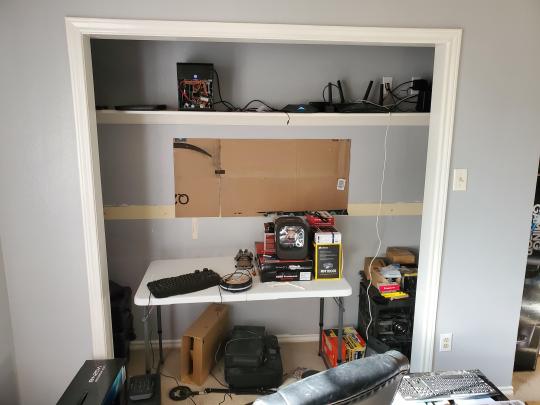
Moved into our first home almost a year ago (October 2019), I picked out a room that had 2 closets for my media/game/office area. Since the room isn't massive, I decided to build a desk into closet #1 to save on space. Here 1 of 2 shelves was ripped off, the back area was repainted gray. A piece of card board was hung to represent my 49 inch monitor and this setup also gave an idea how high I needed the desk.
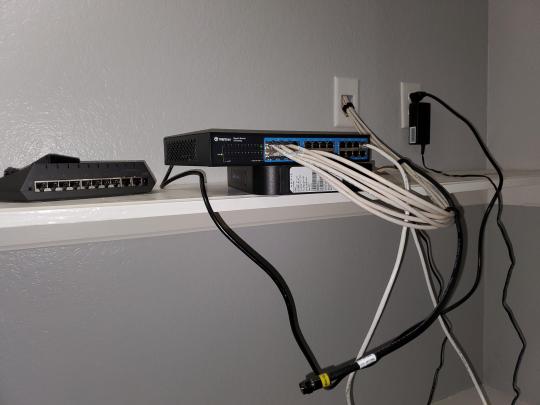
On my top shelf this was the initial drop for all my Cat6 cabling in the house, I did 5 more runs after this (WAN is dropped here as well).

I measured the closet and then went to Home Depot to grab a countertop. Based on the dimensions, it needed to be cut into an object shape you would see on Tetris.

Getting to work, cutting the countertop.
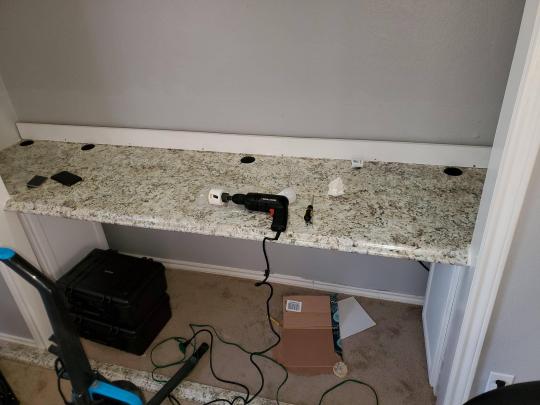
My father-in-law helped me cut it to size in the driveway and then we framed the closet, added in kitchen cabinets to the bottom (used for storage and to hide a UPS). We ran electrical sockets inside the closet. I bought and painted 2 kitchen cabinets which I use for storage under my desk as well.

The holes allowed me to run cables under my desk much easier, I learned many of these techniques on Battlestations subreddit and Setup Wars on Youtube. My daughter was a good helper when it came to finding studs.
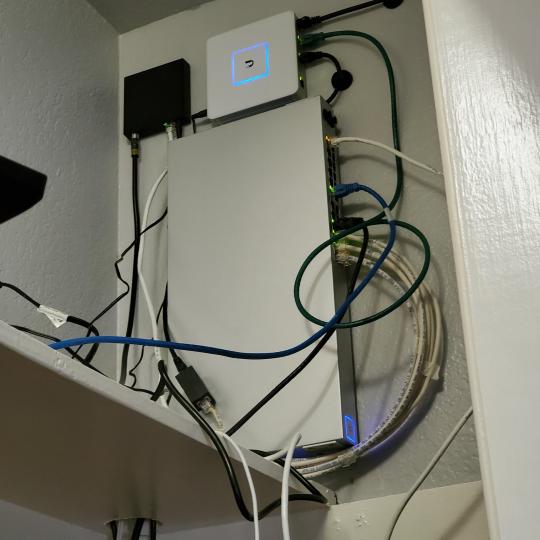
Some of my cousins are networking engineers, they advised me to go with Unifi devices. Here I mounted my Unifi 16 port switch, my Unifi Security Gateway (I'll try out pfSense sometime down the line), and my HD Homerun (big antenna is in the attic). I have Cat6 drops in each room in the house, so everything runs here. On my USG, I have both a LAN #2 and a LAN #1 line running to the 2nd closet in this room (server room). This shot is before the cable management.
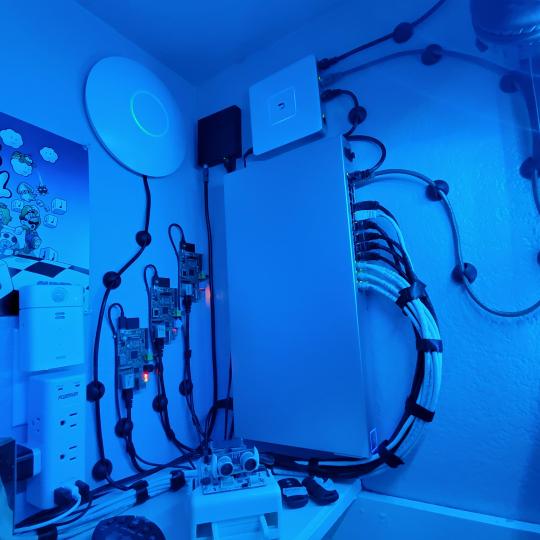
Cable management completed in closet #1. Added an access point and connected 3 old Raspberry Pi devices I had laying around (1 for PiHole - Adblocker, 1 for Unbound - Recursive DNS server, and 1 for Privoxy - Non Caching web proxy).

Rats nest of wires under my desk. I mounted an amplifier, optical DVD ROM drive, a USB hub that takes input from up to 4 computers (allows me to switch between servers in closet #2 with my USB mic, camera, keyboard, headset always functioning), and a small pull out drawer.

Cable management complete, night shot with with Nanoleaf wall lights. Unifi controller is mounted under the bookshelf, allows me to keep tabs on the network. I have a tablet on each side of the door frame (apps run on there that monitor my self hosted web services). I drilled a 3 inch hole on my desk to fit a grommet wireless phone charger. All my smart lights are either running on a schedule or turn on/off via an Alexa command. All of our smart devices across the house and outside, run on its on VLAN for segmentation purposes.

Quick shot with desk light off. I'm thinking in the future of doing a build that will mount to the wall (where "game over" is shown).

Wooting One keyboard with custom keycaps and Swiftpoint Z mouse, plus Stream Deck (I'm going to make a gaming comeback one day!).

Good wallpapers are hard to find with this resolution so pieced together my own.
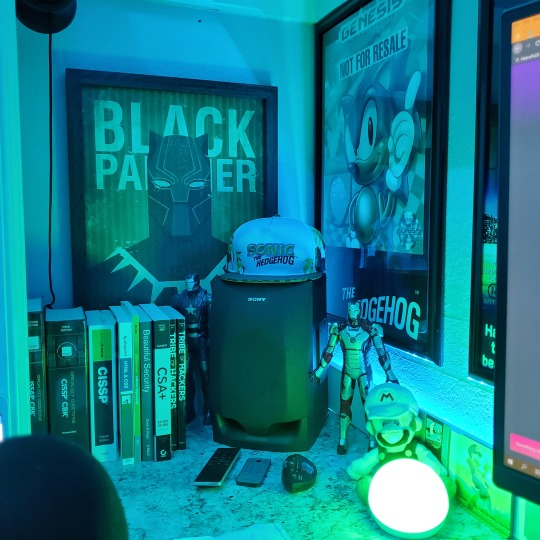
Speakers and books at inside corner of desk.

Speakers and books at inside corner of desk.

Closet #2, first look (this is in the same room but off to the other side). Ran a few CAT6 cables from closet #1, into the attic and dropped here (one on LAN #1, the other on LAN #2 for USG). Had to add electrical sockets as well.
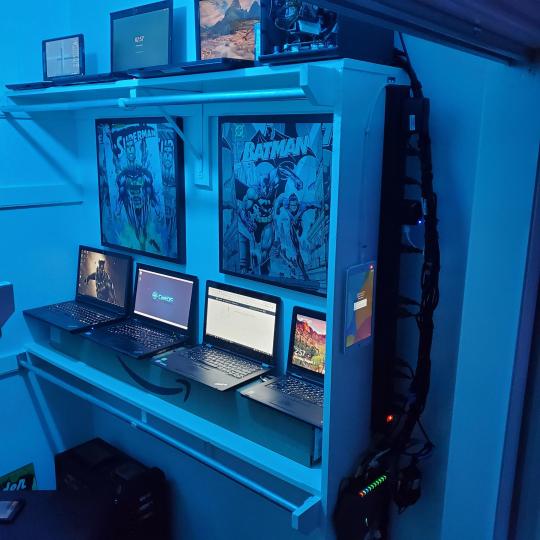
I have owned a ton of Thinkpads since my IBM days, I figured I could test hooking them all up and having them all specialize in different functions (yes, I have a Proxmox box but it's a decommissioned HP Microserver on the top shelf which is getting repurposed with TrueNAS_core). If you're wondering what OSes run on these laptops: Windows 10, Ubuntu, CentOS, AntiX. All of these units are hardwired into my managed Netgear 10gigabit switch (only my servers on the floor have 10 gigabit NICs useful to pass data between the two). Power strip is also mounted on the right side, next to another tablet used for monitoring. These laptop screens are usually turned off.
Computing inventory in image:
Lenovo Yoga Y500, Lenovo Thinkpad T420, Lenovo Thinkpad T430s, Lenovo Thinkpad Yoga 12, Lenovo Thinkpad Yoga 14, Lenovo Thinkpad W541 (used to self host my webservices), Lenovo S10-3T, and HP Microserver N54L

Left side of closet #2
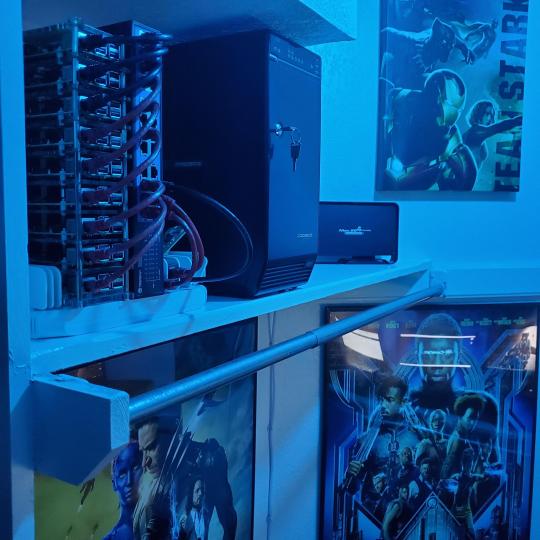
**moved these Pis and unmanaged switch to outside part of closet**
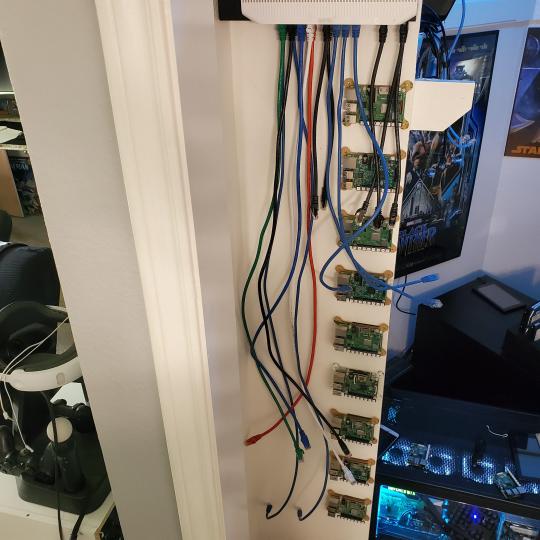
Since I have a bunch of Raspberry Pi 3s, I decided recently to get started with Kubernetes clusters (my time is limited but hoping to have everything going by the holidays 2020) via Rancher, headless. The next image will show the rest of the Pis but in total:
9x Raspberry Pi 3 and 2x Raspberry Pi 4
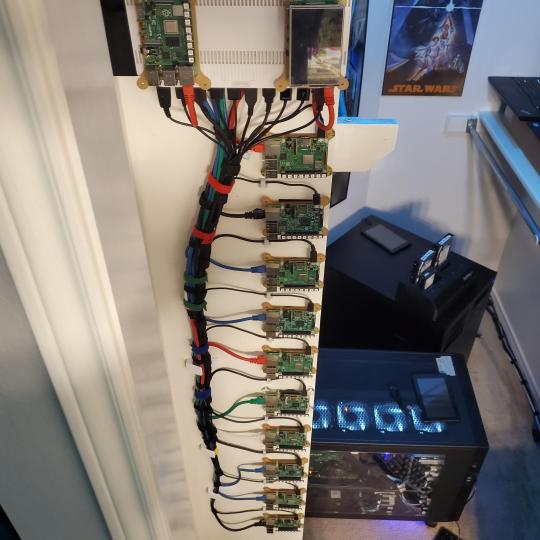
2nd shot with cable management. The idea is to get K3s going, there's Blinkt installed on each Pi, lights will indicate how many pods per node. The Pis are hardwired into a switch which is on LAN #2 (USG). I might also try out Docker Swarm simultaneously on my x86/x64 laptops. Here's my compose generic template (have to re-do the configs at a later data) but gives you an idea of the type of web services I am looking to run: https://gist.github.com/antoinesylvia/3af241cbfa1179ed7806d2cc1c67bd31
20 percent of my web services today run on Docker, the other 80 percent are native installs on Linux and or Windows. Looking to get that up to 90 percent by the summer of 2021.
Basic flow to call web services:
User <--> my.domain (Cloudflare 1st level) <--> (NGINX on-prem, using Auth_Request module with 2FA to unlock backend services) <--> App <--> DB.
If you ever need ideas for what apps to self-host: https://github.com/awesome-selfhosted/awesome-selfhosted
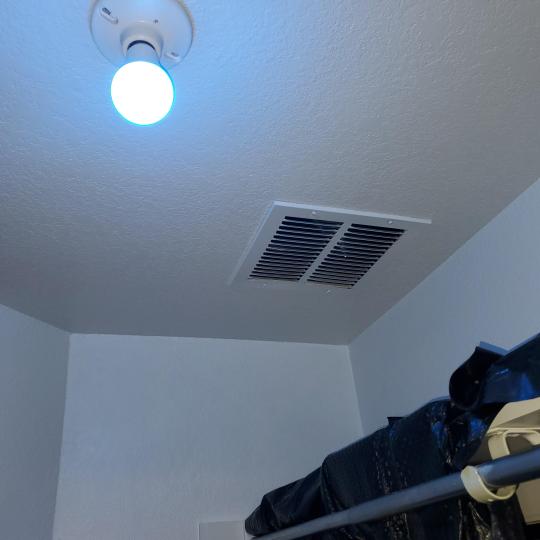
Homelabs get hot, so I had the HVAC folks to come out and install an exhaust in the ceiling and dampers in the attic.
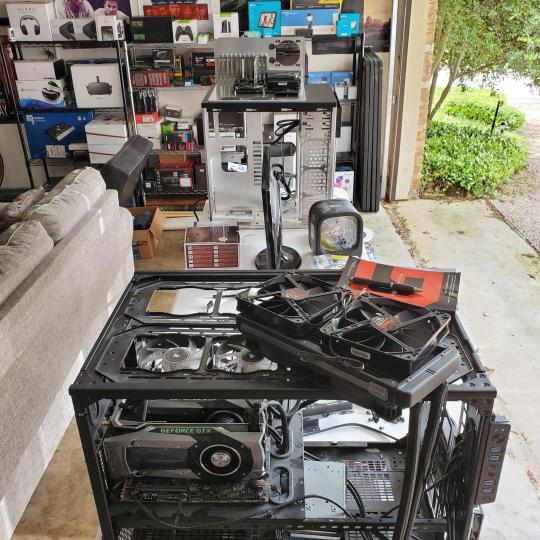
I built my servers in the garage this past winter/spring, a little each night when my daughter allowed me to. The SLI build is actually for Parsec (think of it as a self hosted Stadia but authentication servers are still controlled by a 3rd party), I had the GPUs for years and never really used them until now.
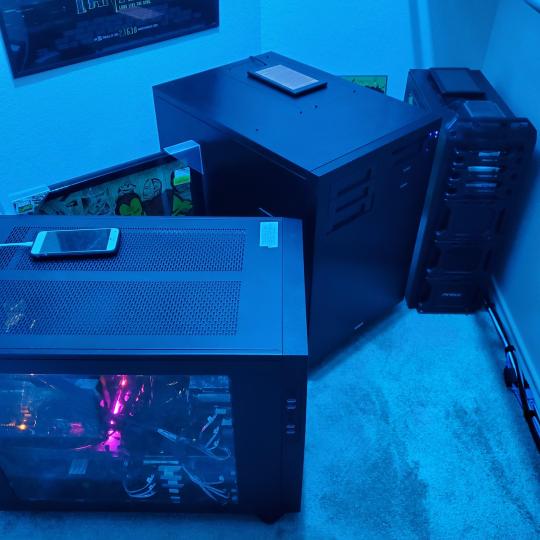
Completed image of my 2 recent builds and old build from 2011.
Retroplex (left machine) - Intel 6850 i7 (6 core, 12 thread), GTX 1080, and 96GB DDR4 RAM. Powers the gaming experience.
Metroplex (middle machine) - AMD Threadripper 1950x (16 core, 32 thread), p2000 GPU, 128GB DDR4 RAM.
HQ 2011 (right machine) - AMD Bulldozer 8150 (8 cores), generic GPU (just so it can boot), 32GB DDR3 RAM.

I've been working and labbing so much, I haven't even connected my projector or installed a TV since moving in here 11 months ago. I'm also looking to get some VR going, headset and sensors are connected to my gaming server in closet #2. Anyhow, you see all my PS4 and retro consoles I had growing up such as Atari 2600, NES, Sega Genesis/32X, PS1, Dreamcast, PS2, PS3 and Game Gear. The joysticks are for emulation projects, I use a Front End called AttractMode and script out my own themes (building out a digital history gaming museum).
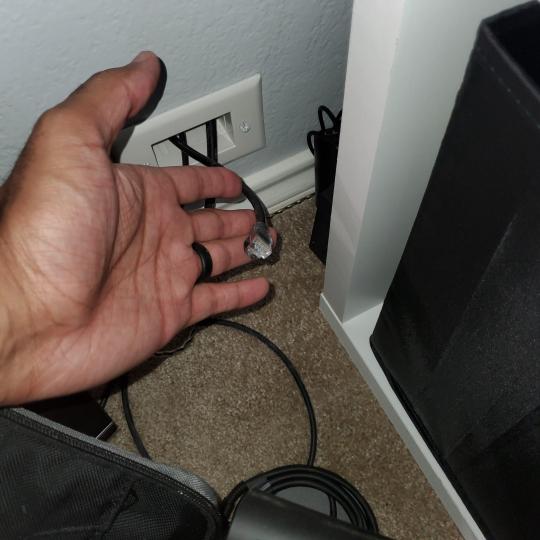
My longest CAT6 drop, from closet #1 to the opposite side of the room. Had to get in a very tight space in my attic to make this happen, I'm 6'8" for context. This allows me to connect this cord to my Unifi Flex Mini, so I can hardware my consoles (PS4, PS5 soon)

Homelab area includes a space for my daughter. She loves pressing power buttons on my servers on the floor, so I had to install decoy buttons and move the real buttons to the backside.
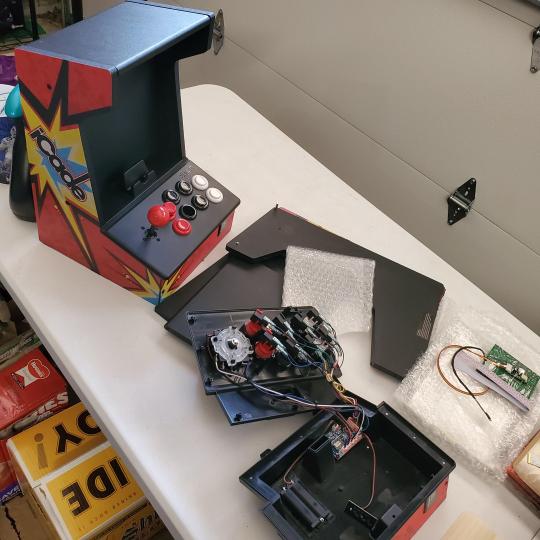
Next project, a bartop with a Raspberry Pi (Retropie project) which will be housed in an iCade shell, swapping out all the buttons. Always have tech projects going on. Small steps each day with limited time.
6 notes
·
View notes
Text
Kubernetes alternatives to Spring Java framework
Spring Cloud and Kubernetes both complement each other to build a cloud-native platform and run microservices on the Kubernetes containers. Kubernetes provides many features which are similar to Spring Cloud and Spring Config Server features. Spring framework has been around for many years. Even today, many organizations prefer to go with Spring because it provides many advanced features with…
View On WordPress
0 notes
Text
0 notes
Link
0 notes
Text
Microservices Architecture with Spring Cloud
What are microservices?
Microservices is an architecture(service-oriented architecture) (SOA). In this architecture, applications are broken down into various services. The motivation behind this is separation and modularity.
Monolithic architecture and microservices are more beneficial.
We don’t need to specify all business logic into a single software module. It leads to complexity and time-consuming debugging.
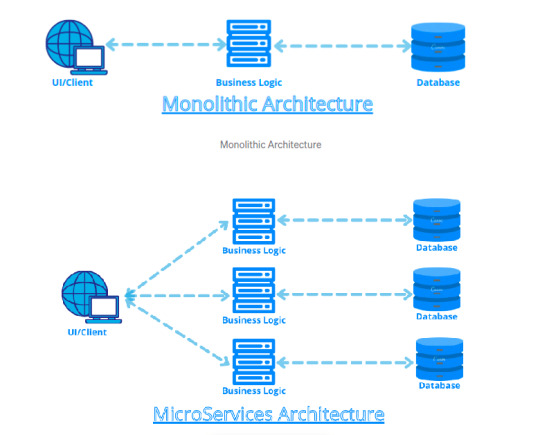
In the above diagram, as we can see, we have only one unit of application in a monolithic architecture. In a microservices architecture, we can see three different services.
Advantages
Increases scalability
More flexibility
Modular architecture
Ease of introducing new features
More reliable and robust structure
Challenges
Cost management
Network latency and load balancing
Complexity at the end-to-end testing
Health Care Example
Let’s take an example
Spring Cloud
It helps us build microservices architecture with various components it provides. Spring cloud helps us manage communication, security threats, maintenance and fault tolerance with different components. Let’s see them one by one.
Spring Cloud Components
Spring Cloud Config Server
Feign Client
Service Discovery and Registry with Eureka
Spring Cloud Gateway
Resillience4j
Spring Cloud Bus
Spring Cloud -> Config Server
Config server uses the git repo to store configurations.
Ease of managing configuration of multiple microservices in a single place
Configurations can be managed with the application.yaml / properties files within a git repo
Each microservice can connect to the config server and get the required configurations
Spring Cloud -> Feign Client
Microservices need to communicate with each other to exchange information. Feign client can be used for that learn more
#microservices#cloud blogs#spring#Healthcare#healthcare software development company#Healthcare interoperability#healthcare solutions
0 notes
Text
Create Spring Cloud Configuration Server | Setup Eureka Service Discovery Registry Server
Full Video Link https://youtu.be/Exoy4ZNAO9Y Hello friends, new #video on #springcloud #configserver #eureka #servicediscovery setup is published on #codeonedigest #youtube channel. @java #java #aws #awscloud @awscloud @AWSCloudIndia #sal
In this video we will learn how to create spring cloud configuration server and eureka service registry server step by step in spring boot framework. Service registry will be use for service discovery. Configuration server is used to store application configuration in central storage. Application, microservices connect configuration server to fetch respective configuration from central…

View On WordPress
#config server#config server firewall#config server in microservices#config server in spring boot example#config server in spring boot microservices#config server spring#config server spring boot#config server spring boot github#config server spring cloud#configuration server#configuration server dns#configuration server in microservices#configuration server spring boot#configuration server step by step#eureka service#eureka service discovery#eureka service discovery example#eureka service discovery example spring boot#eureka service discovery spring boot#eureka service in microservices#eureka service registry#eureka service registry example#eureka service registry spring boot#eureka service spring boot
0 notes
Text
Java ver conexiones al router

#Java ver conexiones al router how to
#Java ver conexiones al router pdf
#Java ver conexiones al router generator
#Java ver conexiones al router full
Sample Android app using clean android-modular-apps Skeleton: Silex framework php and webpack + es6 + sass architecture frontend ionic1todos
#Java ver conexiones al router how to
Sample demonstrating how to delegate authentication in jsreport to an external authorization server to support Single Sign front-silex Simple Router Controller api-with-loopbackĪPI REST build with Loopback.io jsreport-with-author… Timer is a simple coundown app useful for talks and vertical-navigationĪ simple drawing app for Firefox Mozillians_on_Twitte…Ī payload reader for Bitbucket jp-router Playing and learning with react docker-critical-cssĬritical CSS with Docker, puppeteer and flashbitacora Primera aplicacion web para proyecto Open Data de la Municipalidad de react101
#Java ver conexiones al router full
Mira películas y series en español en HD y full HD al instante desde tu compresor-de-imagene…Ĭompresor de imágenes con Google-docs-cloneĪ simple google docs clone made with grunt-external-confi…Įxample of split grunt config file in multiple openhuamanga is still in lowdb-recursiveĭemo del uso de pageres con gulp-primeros-pasos Servo is my server dummy raml-js-webservice-g… Proyecto en JQuery Mobile para construir una web móvil con información del servicio de transporte Metropolitano en Lima, servo Redmine Issues Rest API Client for Metropolitano-Mobile Mapa hidrografico en openlayers del didactic-react (beta) en desarrollo por users-graphql-exampl…Ī small example using opendata-rios-peru JqTree, Spring MVC, GoogleAppEngine jade-examplesĮjercicio demo para el uso de SubeAlMetroĮvaluate a script function on a page with Chrome jsreport-pugĮxperimento tecno-socio-cultural restableciendo conexiones. Notas y ejemplos para presentación en reunión de JavaScript Perú 10 Dic jqtree-spring-mvc-ga… Set and get a data object on an css-url-versioner
#Java ver conexiones al router generator
Un simple boilerplate para el uso de universal js con react, redux y jade-php-twigĪ Yeoman generator for creating your own chatbot using the Hubot mvhostĬreate simple virtualhost for apache2 with EarthquakeĪ CouchDB OAuth working example in htmlService-get-set-…įor Google Apps Script HtmlService. Mira películas y series en español en HD y full HD al couchminĪ command line tool to manage multiple local and remote CouchDB curso-reactjsĭemos y Ejemplos para el curso de universal-redux-boil… Includes: babel, xo, webpack and skeletorĮstructura base para un proyecto basado en jade, stylus, es2015. Reader of dependencies from package.json on es2015-nodejs-boiler…Įs2015 nodejs boilerplate. Node.js modules speed test: C++ vs jscomplexĪ colorful reporter for maintainability index via mydependencies Import sequelize models automagically horseshoeĪ wrapper around nodemailer used for sending email using handlebars json-schema-sugarĬreate a JSON Schema without the pain of writing it node-cppspeed
#Java ver conexiones al router pdf
Jsreport recipe which renders pdf from html using electron gulp-css-url-version…Ī gulp plugin for versioning the CSS property: gulp-emailĪ gulp plugin to send emails with or without attachments from a stream of sequelize-auto-impor… Highly scalable html conversion using electron workers jsreport-electron-pd… Plus for Trello chrome extension, web & mobile electron-html-to Run electron scripts in managed workers Plus-for-Trello 🇵🇪 A list of cool projects made in Peru Contents

0 notes
Text
Zipsplit windows

#Zipsplit windows how to#
#Zipsplit windows zip file#
#Zipsplit windows archive#
#Zipsplit windows zip#
Java: build OCI compatible image for Spring Boot web app using jib.Prometheus: sending a test alert through AlertManager.Prometheus: adding a Grafana dashboard using a ConfigMap.Prometheus: monitoring a custom Service using ServiceMonitor and PrometheusRule.Prometheus: monitoring services using additional scrape config for Prometheus Operator.Prometheus: installing kube-prometheus-stack on a kubeadm cluster.Kubernetes: independent nf for CoreDNS with kubeadm.Kubernetes: independent nf for CoreDNS with K3s.Kubernetes: custom upstream for domain with CoreDNS.Buildah: Installing buildah and podman on Ubuntu 20.04.Java: creating OCI-compatible image for Spring Boot web using buildah.Kubernetes: accessing the Kubernetes Dashboard with least privilege.KVM: configuring a base Window2019 instance with Sysprep.KVM: creating a Windows2019 Domain Controller using Powershell.KVM: Creating a Windows2019 ADFS server using Powershell.Gradle: fixing the gradle wrapper for a Java project.GoLang: Installing the Go Programming language on Ubuntu 20.04.Microsoft: configuring an Application Group for OAuth2/OIDC on ADFS 2019.Java: Spring Security OAuth2/OIDC protecting Client App and Resource Server.Gradle: interactive JDWP debugging of bootRun gradle task in Eclipse IDE.Python: Flask-OIDC protecting Client App and Resource Server using Windows 2019 ADFS.Kubernetes: Keycloak IAM deployed into Kubernetes cluster for OAuth2/OIDC.Kubernetes: copying files into and out of containers without ‘kubectl cp’.OAuth2: Configuring okta for OAuth2/OIDC.OAuth2: Configuring Google for OAuth2/OIDC.KVM: Creating a bridged network with NetPlan on Ubuntu 22.04.Linux: Mounting a loopback ext4/xfs filesystem to isolate or enforce storage limits.
#Zipsplit windows zip#
Linux: Excluding directories when using zip.
Linux: Use stat to verify permissions and ownership.
Ubuntu: Creating a Samba/CIFS share to quickly share files with Windows.
Linux: Using zip/unzip to add, update, and remove files from a Java jar/war.
Valid suffixes for size units are (b|k|m|g).
#Zipsplit windows archive#
# OR mend original archive, but do not extract content yetĬreate split archive on Linux, extract on WindowsĬonversely, if you want to create a split archive from Linux with 100k per file: 7z -v100k a fromlinux.7z įrom Window you would right-click on the “fromlinux.7z.001” file, and select “Extract here” to unzip the content. Then you can transfer this to a Linux host and use the following to extract it. I find that using 7zip provides easy interoperability across Linux and Windows.Ĭreating a split archive on Windows is detailed in posts like this (Note that it works using either 7zip or zip format). While there are many ways to do the same thing using utilities like zip, split, etc. Taking this a step further and splitting this archive into manageable chunks allows you to take advantage of parallel transfer. If you’d like to change the location where the files will be extracted, click “Browse,” and then navigate to the desired drive or folder.If you are transferring large files between systems, it can be advantageous to create a compressed archive using a tool like 7zip. In the “Extract Compressed (Zipped) Folders” window that appears, you’ll see the current file path as the default location for the unzipped files. Next, right-click the file and select “Extract All” in the menu.
#Zipsplit windows zip file#
First, locate the ZIP file that you’d like to extract in File Explorer.
#Zipsplit windows how to#
RELATED: Everything You Need to Know About Zip Files How to Extract a Zip File in Windows 11Įxtracting (unzipping) ZIP files in Windows 11 is just as easy as zipping them. Now that you have a ZIP file, you can copy it or share it like any other kind of file. When you’re ready, press Enter.Īnd that’s all there is to it! Pretty simple. Type a new file name or leave the default name in place. The ZIP file name will highlight, allowing you to type in whatever name you’d like. After a moment, your ZIP file will appear in the same folder as the source files that you just compressed.

0 notes
Text
Get to Know the Difference: Spring Vs Spring Boot

Since Spring supports a number of frameworks, including Struts, JSP, Hibernate, and others, we might compare it to the framework of frameworks. Spring is a lightweight application framework. Making standalone, professional Spring-based Applications is simple using Spring Boot. It is a microservice creation framework built on the Java platform. Word "spring boot" is composed of two words. Seasonal and Boot Combining the words spring and bootstrap means that the first portion of spring stands for the spring framework. Something that enables you to bootstrap a spring application from scratch is referred to as spring boot. The key distinction between spring and spring boot will be explained by XcelTec, a top provider of Java development services.
Difference between Spring Vs Springboot:
Where it’s used?:
A Java EE framework called Spring is used to create applications.
REST API development is the major use of the Spring Boot framework.
Key feature:
Dependency injection, a design method that removes dependencies from computer code to make the programme easier to maintain and test, is the core or most significant component of the Spring framework.
Autoconfiguration is the primary feature of Spring Boot. The process of automatically configuring a Spring application based on dependencies identified on the classpath is known as "Spring Boot autoconfiguration."
Through the elimination of the requirement to define some beans that are a part of the auto-configuration classes, auto-configuration can speed up and simplify development.
Why it’s used:
The purpose of Spring is to simplify Java EE (Enterprise Edition) development so that developers may work more efficiently. For quicker application development, Spring Boot adds the RAD (Rapid Application Development) functionality to the Spring framework.
Type of Application Development:
A loosely linked application can be created with the help of the spring framework.
A stand-alone application can be made with the aid of Spring Boot.
Servers’ dependency:
We must explicitly configure the servers in the Spring framework in order to test the Spring Project.
Tomcat and Jetty are just two of the built-in or embedded servers that Spring Boot offers.
In-memory database support:
The in-memory database is not supported by the spring framework.
H2 is one of the in-memory databases that Spring Boot supports.
Boilerplate code:
Even for simple tasks, the Spring framework requires too many lines of boilerplate code.
You don't use boilerplate code, which saves time and boosts output.
Dependencyes
To construct a web application, Spring Framework needs a number of dependencies.
On the other side, Spring Boot only requires one dependency to make an application functional. Additional dependencies that are needed during build time are added by default to the final archive.
HTTP Authentication
In order to enable security confirmations, HTTP Basic Authentication specifies that a number of requirements and configurations must be enabled. To configure security in an application, Spring needs both the spring-security-web and spring-security-config requirements. Next, we must include a class that uses the @EnableWebSecurity annotation that extends the Web Security Configure Adapter.
These dependencies are also necessary for Spring Boot to function, but we only need to specify the spring-boot-starter-security requirement since this will already have added all the necessary dependencies to the class path.
Testing
Due to the substantial amount of source code, testing Spring Boot is more challenging than testing Spring Boot.
Spring Boot testing is simpler because there is less source code to maintain.
XML Configuration
The Spring framework needs XML Configuration.
In Spring Boot, no XML configuration is required.
CLI Tools
There is no CLI tool offered by the Spring framework for creating and testing apps.
For creating and testing Spring Boot apps, Spring Boot offers a CLI tool.
Plugins
In contrast to Spring Boot, the Spring framework does not offer any plugins for Maven, Gradle, etc.
Maven and Gradle build tool plugins are offered by Spring Boot. The packaging of executable jars is one of the functionalities provided by the Plugins.
Visit to explore more on Get to Know the Difference: Spring Vs Spring Boot
Get in touch with us for more!
Contact us on:- +91 987 979 9459 | +1 919 400 9200
Email us at:- [email protected]
0 notes
Text
Denham Springs Louisiana On Site Computer PC & Printer Repair, Network, Voice & Data Wiring Services
Denham Springs Louisiana Most Dependable Onsite Computer System, PC and Printer Repairs, Networking, and Voice and Data Cabling Services.
The Most Thorough Onsite Tech Providers Coverage Available in Denham Springs and Throughout the Entire State of Louisiana.
Computech Technology Services offers high quality onsite computer repair, networking, and voice and data cabling services throughout the entire city of Denham Springs Louisiana. Our skilled, tech industry certified onsite computer repair and network technology professionals travel straight to your Denham Springs location to supply quick, cost effective installation, configuration, diagnostic and repair work on an incredibly wide variety of different computer, printer, and voice and data networking technologies. Whether you want Windows OS error troubleshooting carried out on your desktop or laptop workstation, Virus Removal, or complex hardware troubleshooting and repair services for MB’s, RAM, CPU’s, or HD’s, our top notch computer system PC service technicians have you covered. If you need networking services installation, configuration and repair services including full voice and data structured cabling services, our expert skilled voice and data network specialists are prepared to service your Denham Springs location immediately. Whether you need diagnosis of your ISP modem, network router troubleshooting, or simply need one of our pro Louisiana technicians to pull some brand-new cabling to support your growing network, we have it all covered, quickly and professionally. Give us a call today and learn why we are Louisiana’s top-rated onsite computer system repair, networking, and voice and data structured cabling service supplier – (859) 780-3020.
Denham Springs Louisiana Expert Network Installs, Repair, Voice and Data Cabling Providers.
We Have Pro Voice and Data Network Services Throughout Denham Springs Louisiana.
Computech Technology Services supplies superior voice and data networking services throughout the whole city of Denham Springs, Louisiana. Our expert trained, networking industry licensed network and low voltage voice and data cabling specialists carry out an exceptionally wide range of onsite networking services daily throughout the state of Louisiana. We are the onsite technology service industry leaders, and we have all of your onsite network installation, configuration, troubleshooting, repair, and structured cabling services covered. Our specialists likewise perform onsite wireless wifi heat mapping surveys, installation, and troubleshooting, as well as full Point of Sale network and cabling support services. Whether you need repair work or setup and configuration of existing network router, switch and hardware firewall devices, or troubleshooting and repair of your existing structured cabling, our onsite network specialists have it covered 100 %. Our high quality low voltage inside wiring voice and data contracting services have you covered for a single drop to one thousand cabling drops in your new or older building and construction location, completely compliant, with cabling certifications offered for all Cat5e, Cat6 and Coax structured cabling. Our certified telecom voice network professionals are on call to perform full PBX and VoIP installation, configuration and repair, in addition to complete telecom voice network structured cabling end to end. So, whether you need full cabling installation for a brand-new site, or merely require troubleshooting and repair of your current network cabling or voice and data jacks, we have the ideal onsite solution for you. Reach out and give us a call today and see why so many Louisiana organizations count on our exceptional onsite network and voice and data cabling services! – (859) 780-3020.
Denham Springs Louisiana Network Installation, Repair, Voice and Data Cabling Solutions:
Cat5e and Cat6 Network Cabling Setup and Repair Services Provided in Denham Springs Louisiana.
Voice and Data Cabling Testing & Certifying Solutions.
PBX Installation, Troubleshooting and Repair Solutions Provided Throughout Denham Springs.
Denham Springs Louisiana Business Structured Cabling Network Inside Wiring Providers.
Denham Springs Network Router Installs, Config and Repair Solutions.
Network Rack Installation, Network Cable Management Provider.
Network Switch Diagnosis and Replacement Solutions.
Wireless WiFi Site Survey and Heat Mapping Solutions.
Denham Springs Louisiana Network Installation, Diagnosis & Repair.
VoIP Setup, Troubleshooting, Repair Services and Low Voltage Cabling Providers.
Network Voice and Data Structured Cabling Services Professional.
Voice and Data Jack Repair Services.
SMB Low Voltage Voice & Data Cabling Services.
DMARC Extensions for Broadband, Coax, Cat5e, Cat6 and T-1 for Denham Springs Louisiana Telecom Voice and Data Services.
Wireless WiFi Installation, Diagnostics and Repair Services.
Retail Digital Media Systems Installation and Cabling Providers.
Denham Springs LA Telecom Inside Wiring, Low Voltage, Structured Voice Cabling Services.
Security Video Camera Cabling and Installation Providers.
Denham Springs Louisiana Point of Sale Network Structured Cabling Services.
ISP Modem Testing & Troubleshooting Contractors.
Louisiana Top Choice for Commercial Network Services in:
Retail.
Hospitality.
Industrial.
Medical.
Residential.
Denham Springs Louisiana Onsite Computer System and Printer Setup, Config & Repair Services.
Our Denham Springs Techs Travel Right to Your Site for Unbeatable Onsite Computer PC & Printer Repair Support.
Computech Technology Services supplies high quality professional onsite computer repair services throughout the entire city of Denham Springs, Louisiana. Our PC industry certified, background checked onsite computer system repair technicians are very experienced, are mobile throughout Denham Springs, and travel right to your location to carry out complete PC and printer installs, configuration, and troubleshooting & repairs service. We are not restricted by being a PC vendor specific company, and our onsite PC repair and printer techs hold a wide array of certifications for a very wide range of various makes and models of desktop, laptop computer, and printer types, so we have you covered regardless of your current device type or current setup. Our specialists are also readily available to perform installation, configuration, and repair of Point of Sale systems, for all software and hardware makes, models and types. With over 300 accredited onsite PC and printer repair professionals readily available throughout the state of Louisiana, we have you and all of your onsite technology needs covered, on time, every time. With our mobile onsite services, it’s not necessary to transport your mission critical desktop, laptop computer, or printer into a regional Denham Springs service center, and unlike lots of other gimmicky “PC nerd”, “guru”, and “pc doctor” services, our mobile staff professionals are industry licensed, background checked, and completely vetted to ensure only the highest quality professional onsite services for you and your location. The choice is clear. Give us a call today and let us show you why many Denham Springs services and locals select and count on our complete onsite computer repair and printer services to keep their computers and networks operating like brand new! – (859) 780-3020.
Denham Springs Louisiana Onsite Computer System PC Repair & Printer Services:
Peripheral & External Drive Troubleshooting & Repair.
Speedy, Same Day Scheduling for Onsite Service Calls.
Malware Elimination Services.
Full Service Laptop Computer PC Troubleshooting & Repair Providers Available Throughout Denham Springs.
Data Backup & Recovery Solutions.
Denham Springs LA Commercial Small Business & Enterprise Server Troubleshooting and Repair Services.
Trusted Virus Elimination Providers.
Full Service Denham Springs Louisiana Desktop PC Diagnosis & Repair Solutions.
Adware & Spyware Removal Solutions.
Commercial Retail PC Roll Out Installs & Configuration Solutions Throughout Denham Springs.
Windows 7, 8, 10 OS Errors Support.
PC RAM Troubleshooting & Replacement Services.
Denham Springs Louisiana Point of Sale & Commercial BOH Computer PC & Network Repair Providers.
Motherboard Testing Services.
Power Supply Diagnosis & Replacement.
Computer PC Networking Diagnose & Repair.
HD Diagnosis, Repair & Replacement.
PC CPU Testing & Replacement Providers.
Denham Springs Louisiana Printer Installs, Configuration and Diagnose & Repair Services.
Total PC Optimization Provider.
Louisiana Leading Option for Commercial Computer System Repair Services in:
Retail Hospitality.
Industrial.
Medical.
Residential.
The Trusted Leader in Onsite Technology Services Throughout Denham Springs Louisiana.
Louisiana Best Commercial & Residential, SMB and B2B Onsite Technology Installs, Configuration & Repair Solutions.
Since 2008, Computech Technology Services has offered professional onsite computer system and printer repair services, in addition to networking and tech support services throughout the beautiful city of Denham Springs and the entire state of Louisiana. Our high quality, mobile, IT industry certified onsite PC repair and networking professionals have successfully completed countless service calls throughout the region, and we are on call to service your technology issues today. From computer PC problems, hardware, and software application failures to complete network cabling and technology equipment setup services, we have your onsite requirements covered, quickly and professionally. Whether you need professional onsite services for your local company, branch office, or simply need on call white label information technology onsite smart hands support in Denham Springs, our Louisiana Onsite Tech Services have the quick and inexpensive option for you and your onsite tech requirements. Give us a call today and let us fix your computer, printers, and networking issues, you’ll be delighted that you did – (859) 780-3020.
Superior On Site Tech Support Solutions On Call in Denham Springs Louisiana.
Computech Technology Services of Denham Springs Denham Springs, Louisiana 70706 (859) 780-3020
https://www.computechtechnologyservices.com/denham-springs-louisiana-on-site-computer-printer-repair-network-voice-data-wiring-services/
The post Denham Springs Louisiana On Site Computer PC & Printer Repair, Network, Voice & Data Wiring Services appeared first on Onsite Tech Hub.
from Onsite Tech Hub http://bit.ly/2EP8Q0z via Onsite Technology Services Directory
1 note
·
View note